ISSN ONLINE(2278-8875) PRINT (2320-3765)
ISSN ONLINE(2278-8875) PRINT (2320-3765)
S.Aishwarya1, R.Hemalatha2, M.Yamuna Devi3, J.Vijitha Ananthi4
|
| Related article at Pubmed, Scholar Google |
Visit for more related articles at International Journal of Advanced Research in Electrical, Electronics and Instrumentation Engineering
Several transmission methods are available to improve the network capacity in MANET. Most of the existing works on wireless networks are point–point, Cooperative transmission. In the existing Cooperative transmission, the source node sends packets to destination node through cooperative node but soon after the source node loses its whole energy and stops transmitting the packets. So, now we are introducing the new transmission technique which overcomes the above mentioned problem. In this technique, we are converting the cooperative node as selfish node. The selfish node stops forwarding the received packets to the destination and find another path to reach destination directly. With this method the capacity of network is increased when compared to Cooperative Communication.
Keywords |
| Mobile ad hoc network (MANET), Selfish node, Topology control, Cooperative communication, Network capacity |
INTRODUCTION |
| A Mobile ad-hoc network (MANET) is a self-configuring infra-structure less network of mobile devices connected by wireless. Ad hoc is Latin and means "for this purpose". Each device in a MANET is free to move independently in any direction, and will therefore change its links to other devices frequently. Each must forward traffic unrelated to its own use, and therefore be a router. The primary challenge in building a MANET is equipping each device to continuously maintain the information required to properly route traffic. Such networks may operate by themselves or may be connected to the larger Internet. |
A.COOPERATIVE COMMUNICATIONIN MOBILE AD HOC NETWORK |
| Cooperative communication typically refers to a system where users share and coordinate their resources to enhance the information transmission quality. It is a generalization of the relay communication, in which multiple sources also serve as relays for each other. Early study of relaying problems appears in the information theory community to enhance communication between the source and destination. Recent tremendous interests in cooperative communications are due to the increased understanding of systems have been widely acknowledged, it is difficult for some wireless mobile devices to support multiple antennas due to the size and cost constraints. |
| Recent studies show that cooperative communications allow single-antenna devices to work together to exploit the spatial diversity and reap the benefits of MIMO systems such as resistance to fading, high throughput, low transmitted power, and resilient networks [1]. In a simple cooperative wireless network model with two hops, there is a source, a destination, and several relay nodes. The basic idea of cooperative relaying is that some nodes, which overheard the information transmitted from the source node, relay it to the destination node instead of treating it as interference. Since the destination node receives multiple independently faded copies of the transmitted information from the source node and relay nodes, cooperative diversity is achieved. |
RELATED WORK |
| Topology Control (TC) is one of the most important techniques used in wireless ad hoc and sensor networks to reduce energy consumption (which is essential to extend the network operational time) and radio interference (with a positive effect on the network traffic carrying capacity). The goal of this technique [8] is to control the topology of the graph representing the communication links between network nodes with the purpose of maintaining some global graph property (e.g., connectivity). |
| The paper [3], [4] discusses the impact of topology control on network capacity by introducing a new definition of the expected capacity that is first analyzed in the perspective of cross layer optimization. Based on the analytical result, optimal schemes for neighbour selection and transmission power control, which are two functions of topology control, are studied to maximize the capacity. In the paper [5], we investigate its impacts on network topology and network capacity, which is determined by considerable aspects, such as physical layer capacity, interference, path length, etc. Since cooperative communications enhance physical layer capacity and relay selection impacts network topology directly, we present a Capacity-Optimized Cooperative (COCO) topology control scheme for mobile ad hoc networks (MANETs) with cooperative communications. In the paper [10], we derive the exact expressions for outage probabilities and outage capacities of three proactive cooperative diversity schemes that select a best relay from a set of relays to forward the information. The derived expressions are valid for arbitrary network topology and operating signal to- noise ratio, and serve as a useful tool for network design. |
| In paper [9], we consider finite-state Markov channels in the relay-selection problem. Moreover, we also incorporate adaptive modulation and coding, as well as residual relay energy in the relay-selection process. Topology control in ad-hoc networks tries to lower node energy consumption by reducing transmission power and by confining interference, collisions and consequently retransmissions. Commonly low interference is claimed to be a consequence to sparseness of the resulting topology. In paper [1],[2] we disprove this implication. In contrast to most of the related work claiming to solve the interference issue by graph sparseness without providing clear argumentation or proofs, we provide a concise and intuitive definition of interference. |
| We develop [6], [7] and analyze low-complexity cooperative diversity protocols that combat fading induced by multipath propagation in wireless networks. The underlying techniques exploit space diversity available through cooperating terminals’ relaying signals for one another. We outline several strategies employed by the cooperating radios, including fixed relaying such as amplify-and-forward and decode-and-forward, selection relaying schemes that adapt based upon channel measurements between the cooperating terminals, and incremental relaying schemes that adapt based upon limited feedback from the destination terminal. |
EXISTING METHOD |
| Cooperative communication typically refers to a system where users share and coordinate their resources to enhance the information transmission quality. Cooperative communications allow single-antenna devices to work together to exploit the spatial diversity and reap the benefits of MIMO systems such as resistance to fading, high throughput, low transmitted power, and resilient networks [1]. In a simple cooperative wireless network model with two hops, there is a source, a destination, and several relay nodes. |
| With physical layer cooperative communications, there are three transmission manners in MANETs: direct transmissions, multihop transmissions and cooperative transmissions. Direct transmissions and multi-hop transmissions can be regarded as special types of cooperative transmissions. A direct transmission utilizes no relays while a multi-hop transmission does not combine signals at the destination. The cooperative channel is a virtual multiple-input singleoutput (MISO) channel, where spatially distributed nodes are coordinated to form a virtual antenna to emulate multiantenna transceivers. |
| Several transmission methods are available to improve the network capacity in MANET. They are |
| 1. Traditional direct transmission2. Multi hop transmission3. Cooperative transmission |
| Most of the existing works on wireless networks are point – point. Since only two nodes are involved in the direct transmission, the interference set of a direct transmission is the union of coverage sets of the source node and the destination node. Source node sends packets directly to destination node but soon after the source node loses its whole energy and stops transmitting the packets. The same problem arises between another two nodes. So, now the new transmission technique Cooperative Communication has tremendous interest to overcome the above mentioned problem. In cooperative communication the source node broadcasts its messages to the cooperative node in the first slot. The cooperative node decodes and re-encodes the signal from the source, and then forwards it to the destination in the second slot. With Cooperative Communication the capacity of network is increased by considering both upper layer and physical layer. |
PROPOSED METHID |
| Mobile Ad hoc Networks (MANETs) are on demand, spontaneous, self-administrative, with no infrastructure and plug-n-play networks. In interconnected MANET, the ad hoc network is connected with infrastructure network(s).InCooperative transmission the source node sends packets to destination node through CN. Where CN refers to the cooperative node. |
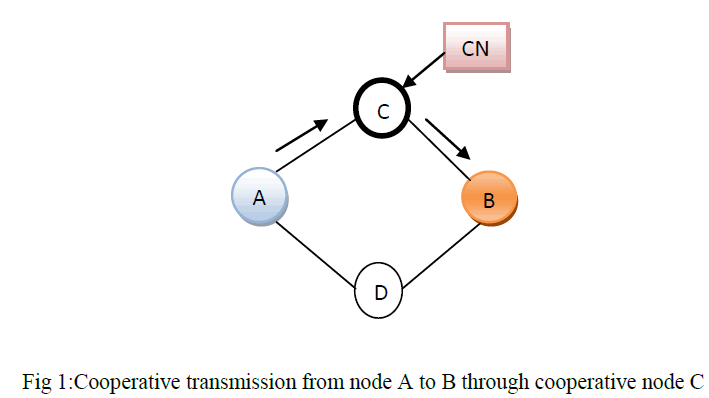 |
| Figure 1explains the cooperative transmission between source and destination node through a cooperative node. The source node A sends packets to the destination node B through the cooperative node C. |
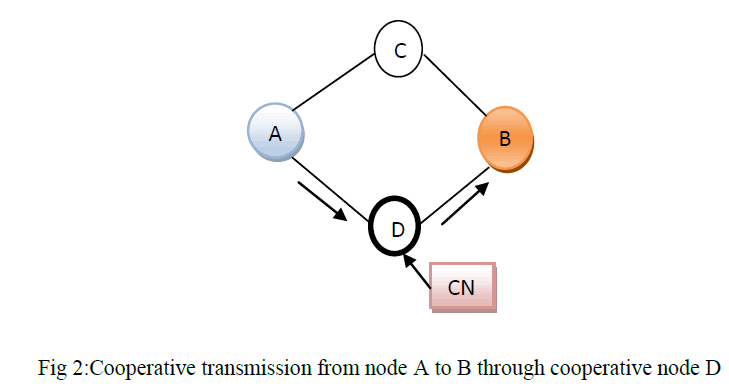 |
| Figure 2 explains the cooperative transmission between source and destination node through a cooperative node. The source node A sends packets to the destination node B through the cooperative node C. Source node A sends packets to destination node B through node D. |
A. ALGORITHM: NCI USING COOPERATIVE COMMUNICATION |
| 1. Connected graph G (V, E) |
| 2. A ← G (V, E) (Source node) |
| 3. B ← G (V, E) (Destination node) |
| 4. C, D← G (V, E) (Cooperative nodes) |
| 5. A ← C → B |
| NCI(Network Capacity Improving)Algorithm for cooperative communication explains that G(V,E) is a whole network which is our input A is source node of G(V,E) , B is destination node of G(V,E), C is cooperative node. Source node A sends packets to destination node B through an intermediate node C. So that, the source node A selects a path for transmission and reaches the destination. |
| In interconnected MANET, the ad hoc network is connected with infrastructure network(s).InCooperative transmission the source node A sends packets to destination node B through cooperative node C. |
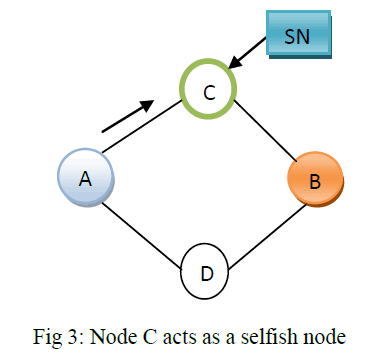 |
| In figure 3 the source node finds node C as selfish node. The selfish node Cstops transmitting the packets to destination node B. so, here there is no cooperation between the nodes and the source node will search for another path for transmission. |
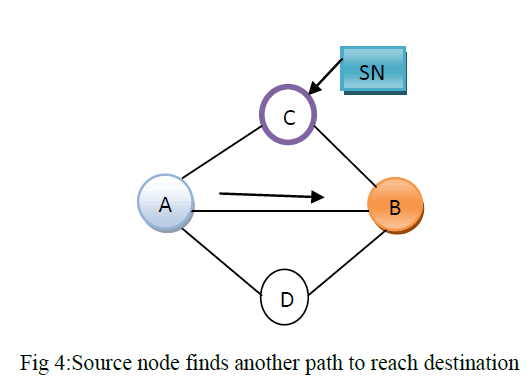 |
| The source node A sends packets to the destination node B through cooperative node C. But the source node finds node C as selfish node. The selfish node Cstops transmitting the packets to destination node B. Therefore source node finds another path to reach destination directly. |
B. ALGORITHM: NCIUSING SELFISH NODE |
| 1. Connected graph G (V, E) |
| 2. A ← G (V, E) (Source node) |
| 3. B ← G (V, E) (Destination node) |
| 4. C ← G (V, E) (Cooperative node) |
| 5. A ← C → B |
| 6. If C ← selfish, A âÃâ¢ÃÂÃâ¹ÃÆ C âÃâ¢ÃÂÃâ¹ÃÆ B |
| 7. A find another path to reach B |
| NCI Algorithm for selfish node explains that G (V, E) is a whole network which is our input A is source node of G (V, E), B is destination node of G(V,E), C is cooperative node. Source node A sends packets to destination node B through an intermediate node C. If the intermediate node is a selfish node, it will not transmit the received packets to the destination node. So, the source node will find another path to reach destination. |
EXPERIMENTAL RESULTS |
| These algorithms evaluate the performance of Cooperative Communication and compare the performance with selfish transmission and improves the network capacity. These algorithms are implemented using network simulator ns2.In the simulation we use 32 nodes. |
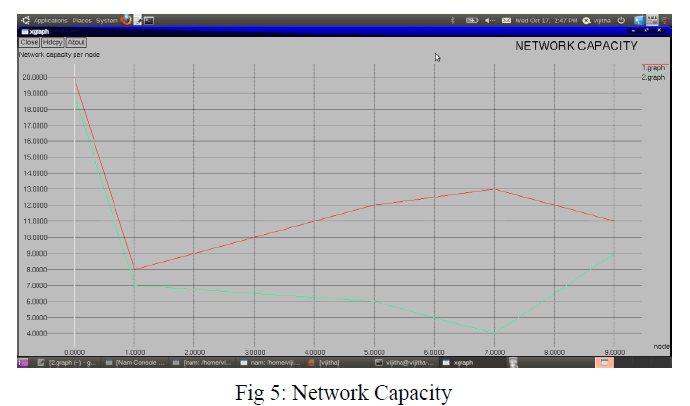 |
| The study on achievable packet delivery rate (Fig. 5) shows good results for the COCO transmission compared to direct transmission .It is proved that network capacity and energy increased in COCO when compared to direct transmission. |
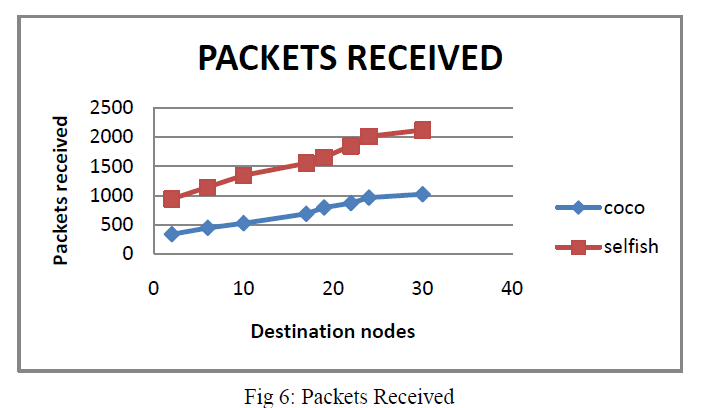 |
| Figure 6 shows the packets received by the destination nodes. Packet received is obtained by number of data packets correctly received by the destinations by the number of data packets originated by the sources. Comparedto Cooperative communication, selfish transmission decreases the packet dropping ratio. |
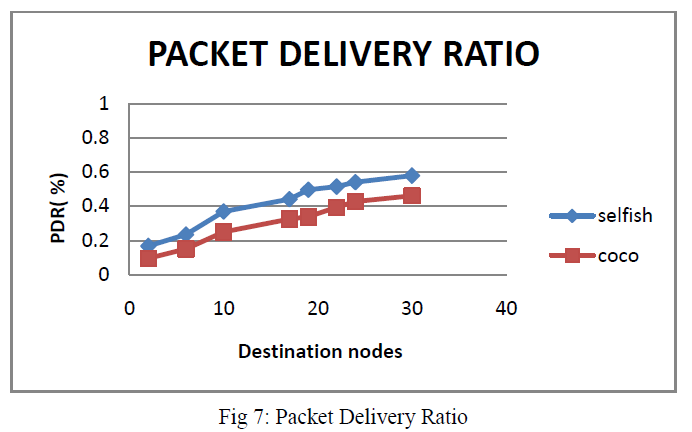 |
| Figure 7 shows the packet delivery ration between destination nodes and PDR%.Packet delivery ratio is obtained by dividing the number of data packets correctly sent by the source minus the number of data packets received by the destination. Packet delivery ratio is defined as the ratio of packets delivered to the destination to those generated by the CBR sources. Compared to Cooperative communication, selfish transmission increases the packet delivery rate. |
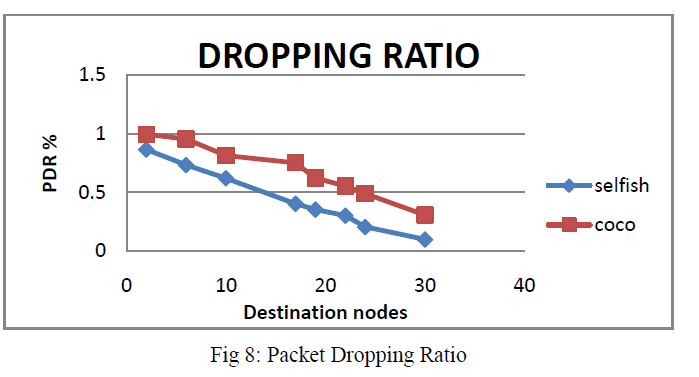 |
| Figure 8 shows dropping ratio between destination nodes and PDR%.Packet dropping ratio is obtained by subtracting the number of data packets correctly received by the destinations by the number of data packets originated by the sources. Packet dropping ratio is defined as the ratio of packets dropped to the destination to those generated by the CBR sources. Compared to Cooperative communication, selfish transmission decreases the packet dropping ratio. |
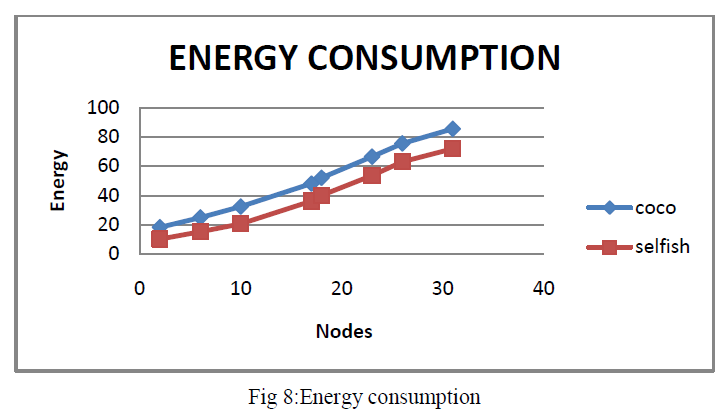 |
| Figure 8 shows the energy consumption between destination and energy. Energy consumption of selfish transmission is lesser than cooperative transmission. |
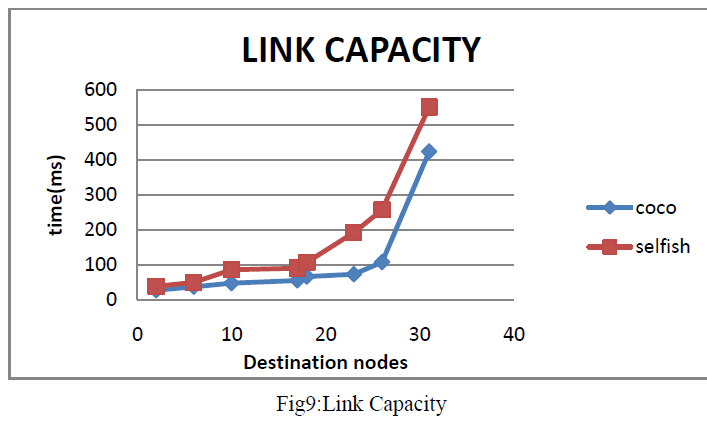 |
| Figure 9 shows the link capacity of cooperative communication and selfish node transmission between destination nodes and time. Link capacity is obtained by dividing the packets received by destination node by simulation time. |
CONCLUSION |
| In this paper, cooperative communication, selfish node transmission in MANETs are considered. To enhance the network capacity, we consider the cooperative node as a selfish node and the selfish stops forwarding the received packets from source to destination, find another path to reach destination directly. Simulation results have shown that selfish node transmission techniques have significant impacts on the network capacity than cooperative communication, and the proposed scheme can substantially improve the network capacity in MANETs. |
References |
|